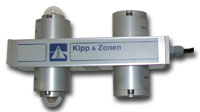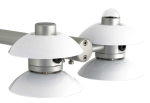This product is not available for new orders. We recommend ordering: CNR4-L.

| Services Available | |
|---|---|
| Repair | No |
| Free Support | No |
Visão Geral
The CNR1 net radiometer by Kipp & Zonen is for applications requiring research-grade performance. The radiometer measures the energy balance between incoming short-wave and long-wave IR radiation versus surface-reflected short-wave and outgoing long-wave IR radiation. The CNR1 consists of a pyranometer and pyrgeometer pair that faces upward and a complementary pair that faces downward. The pyranometers and pyrgeometers measure short-wave and far infrared radiation, respectively. The CNR1 also includes an RTD to measure the radiometer’s internal temperature and a heater that can be used to prevent condensation. Lead length is 82 ft. For custom cable length, order CNR1-L.
If you need a mounting bracket for a CNR1 or CNR1-L, get advice by clicking the Ask a Question button on this page, or call 435-227-9000 and ask to speak to someone in our Flux group.
Leia maisimagens

Produtos Relacionados
Descrição Técnica
The CNR1 comes with an 82-ft cable length. This net radiometer is for applications requiring research-grade performance. It measures the energy balance between incoming short-wave and long-wave infrared radiation versus surface-reflected short-wave and outgoing long-wave infrared radiation.
The CNR1 consists of a pyranometer and pyrgeometer pair that faces upward and a complementary pair that faces downward. The pyranometers and pyrgeometers measure short-wave and far infrared radiation, respectively. All four sensors are calibrated to an identical sensitivity coefficient.
The CNR1 also includes an RTD to measure the radiometer’s internal temperature, a 4WPB100 module to interface the RTD with the data logger, and a heater that can be used to prevent condensation.
The CNR1 uses six differential or four single-ended and two differential analog channels on the data logger. Data loggers that provide sufficient channels include our CR1000, CR3000, and CR5000.
If you need a mounting bracket for a CNR1 or CNR1-L, get advice by clicking the Ask a Question button, or call 435-227-9000 and ask for someone in our Flux group.
Compatibilidade
Please note: The following shows notable compatibility information. It is not a comprehensive list of all compatible products.
Data Loggers
| Product | Compatible | Note |
|---|---|---|
| 21X (retired) | ||
| CR10 (retired) | ||
| CR1000 (retired) | ||
| CR10X (retired) | ||
| CR200X (retired) | ||
| CR206X (retired) | ||
| CR211X (retired) | ||
| CR216X (retired) | ||
| CR23X (retired) | ||
| CR295X (retired) | ||
| CR3000 (retired) | ||
| CR500 (retired) | ||
| CR5000 (retired) | ||
| CR510 (retired) | ||
| CR800 (retired) | ||
| CR850 (retired) | ||
| CR9000 (retired) | ||
| CR9000X (retired) |
Additional Compatibility Information
Do Not use the UT018 crossarm with the 14364 mounting bracket to fasten the CNR1 to a tower leg. The 14264 mounting bracket should be attached directly to a verticle pole.
Data Logger Considerations
The CNR1 uses six differential or four single-ended and two differential analog channels on the data logger.
Especificações
| Sensors | Kipp & Zonen’s CM3 ISO-class, thermopile pyranometer, CG3 pyrgeometer, PT100 RTD |
| Pyranometer Spectral Response | 305 to 2800 nm |
| Pyrgeometer Spectral Response | 5000 to 50,000 nm |
| Response Time | 18 s |
| Sensitivity Range | 7 to 15 μV W-1 m2 |
| Pyranometer Output Range | 0 to 25 mV |
| Pyrgeometer Output Range | ±5 mV |
| Expected Accuracy for Daily Totals | ±10% |
| Directional Error | < 25 W m-2 (pyranometer) |
| Heating Resistor | 24 ohm, 6 W (at 12 Vdc) |
| CE Compliance | CE compliant under the European Union’s EMC directive |
Documentos Relacionados
Lâminas do produto
Manuais
Perguntas Frequentes Relacionadas
Number of FAQs related to CNR1: 3
Expandir todosRecolher todos
-
If the BR (Bowen Ratio) system is being run on 21X or CR23X dataloggers, a CNR1 net radiometer cannot be used with the system because those data loggers do not have enough input channels. For this reason, Campbell Scientific recommends running a CNR1 out of a separate data logger.
-
CNR1 is a four-output net radiometer. It gives values for incoming short-wave, incoming long-wave, outgoing short-wave, and outgoing long-wave radiation. It also calculates the net radiation and albedo.
-
As a general guide, go at least 1.5 m above the tallest plant (tree) in an ecosystem.
Estudos de Caso
The Geography Department at Bucknell University has implemented a weather station to obtain meteorological data......Leia mais



